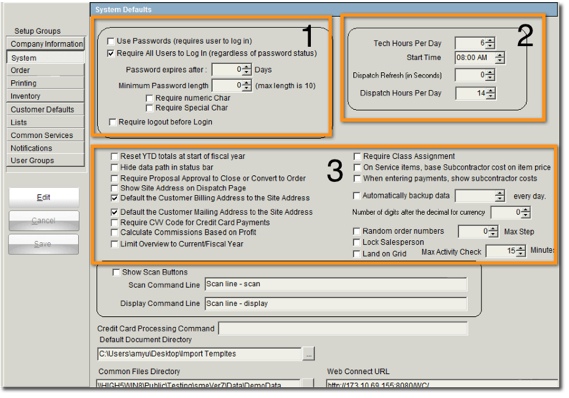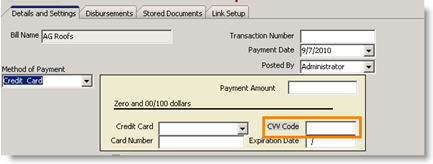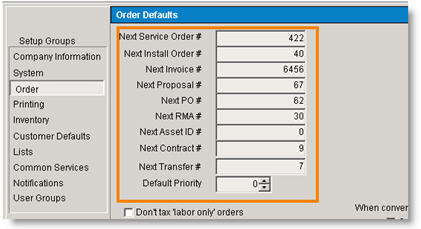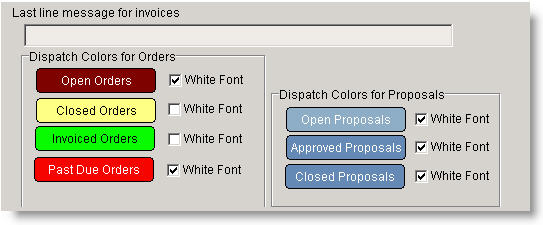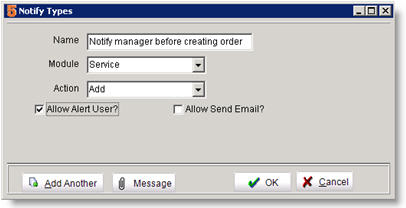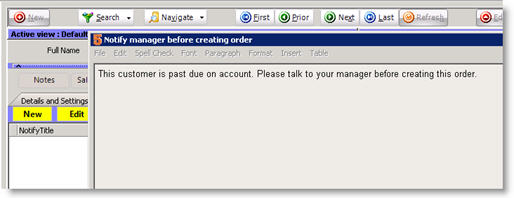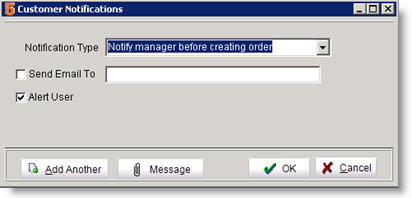Company
In the Setup module, select Company to setup user groups, customize lookup lists (drop down values), set customer defaults and more.
Setup Groups:
Company Information – Upload you logo, select SME colors and set fiscal year starting date.
System – Set password requirements, technician hours and other system settings.
Order – Set next order and invoice numbers, set default exporting to QuickBooks, set dispatch colors and various other order settings.
Customer Defaults – Set default values for customer records, create custom customer fields and decide how you want customer account numbers to be generated.
Lists – Customize the drop down values in fields throughout SME.
Common Services – Assign a key word to a block of text which you can enter into orders and notes throughout SME by selecting the keyword.
Notifications - Setup notification templates which you can assign to customers to alert user when taking action (e.g. alert user to not create an order for customer because they are past due or alert user when creating order that the customer is VIP)
User Groups - Each user needs to be assigned to a user group. The user group determines your user's permission to modules and features throughout SME. Setup user groups here.
Company Information
In this section, you need to add your address and company contact information, upload a logo, select your fiscal year starting date and select SME colors.
Address Information:
The address entered here will display on reports such as service orders and invoices. Click Edit and enter your company address, phone, email and webpage. You might want your email address to be a generic address such as info@... Or sales@...
[[File:CompanyInformation.jpg]
Upload Logo The logo you upload here will display on reports.
- Click Edit (on the left).
- Click Logo Options and select Load.
- Browse for your logo and click Open.
- Click Save.
Select Company Colors
The Company Color you select will show as the main background color in SME. The Secondary color is the color that shows on various buttons (image below)
- Click Edit.
- Click Select Company Color.
- In the Color window, select color and click OK.
Click Save and the color will change.
System
The System Defaults section is where you will set password requirements, technician work hours for dispatch, and various settings and defaults described below.
Password Requirements (1 in image above)
This is where you can require your users to use passwords to log in and set password length requirements. You set the passwords for your users in the Users section of the Setup module.
Technician Work Hours(2 in image above)
Enter the hours your technicians work per day and the Start Time. The Order Dispatch window will use the start time and hours to determine the hours you can schedule your techs.
Leave 0 in the Dispatch Refresh field.
Additional System Defaults (3 in image above)
Below is a description of each setting, however most of the settings in this section are self explanatory.
Reset YTD totals at the start of fiscal year – YTD totals are found in the Customer Accounts tab, showing the customer totals year to date.
Hide data path in status bar – the status bar is at the bottom of SME.
Require Proposal Approval to Close or Convert to Order – If checked, proposals require approval before they can convert them to orders. If not approved yet, users will receive a message prompting approval.
Show Site Address on Dispatch Page – If checked, the site address will show on the order scheduled on the Order Dispatch window.
Default the Customer Billing Address to the Site Address – If this is checked, the address you type in the site address tab will carry over to the billing address tab. This saves you from having to click “set from site” on the billing tab.
Default the Customer Mailing Address to the Site Address - If this is checked, the address you type in the site address tab will carry over to the mailing address tab. This saves you from having to click “set from site” on the mailing tab.
Require CW Code for Credit Card Payments – If this is checked, user is required to enter the CW code when entering payment by credit card.
Calculate Commission Based on Profit – If this is checked, the salesperson’s commission will be calculated off the profit, not the total.
Limit Overview to Current/Fiscal Year – The overview is found by clicking
![]() in the main form elements tabs.
in the main form elements tabs.
Require Class Assignment – If checked, user cannot save customer record until the Class is selected.
On Service items, base Subcontractor cost on item price – When adding a service item to an order, there is a percent markup field for the service and you can also select a subcontractor to perform the service. If this option is NOT check, the percent markup is multiplied by the service cost to get the price. If this box IS checked, the price is fixed and cost paid to subcontractor is based on a percentage off the price.
When entering payments, show subcontractor costs – If this option is checked, when a payment is received SME it will check all the orders and highlight any service items with subcontractors selected and show the cost.
Automatically backup data – It is NOT recommended to use SME utilities for backup. We recommend iBackups or some other backup specifically for SQL Server. The SME backup is good for backing up the user settings.
Number of digits after the decimal point for currency – Windows now handles this through regional settings.
Random order numbers – If checked, order numbers will be generated randomly
Scan - If you have a scanner that can accept a command line then you can set this up and within stored docs you can launch your scanner for scan or display.
Order
The Order Defaults section in the Setup Module where you will set various defaults such as colors associated with orders, beginning order and invoice numbers, finance charge past due dates.
When getting started with SME, you may want to set the next order numbers, proposal number or next PO number. If you previously used a number system, you can set SME to pick up where you left off here.
- In SME, select the Setup module.
- Click Order.
- Click Edit on the left.
- Fill out the next number in the section on the top left (circled in the image to the right)
- Click Save on the left.
In the Order Dispatch window you can identify whether an order is open, closed, invoiced or past due by color. You can choose colors that make sense for your team.
- Locate the Dispatch Colors for Orders section (image below)
- Click Open Orders and select the color from the color picker. Follow the same for closed, invoiced and past due orders.
- Uncheck White Font to change the font to black.
- Click Save on the left.
Default Export to QuickBooks Options
If you are syncing SME with QuickBooks, choose which SME forms export to QuickBooks by default. Click Default Export to QuickBooks Settings to learn how.
Customer Defaults
In the Customer Defaults section you can set default values for the various customer fields and create custom fields for the customer record.
Watch the video below or read the instructions below on setting the customer defaults. <videoflash>b20ssBbRSmA</videoflash>
To set SME to generate account numbers for your customers
- In SME, select the Setup module.
- Click Company.
- Click Customer Defaults.
- Click Edit on the left.
- Check Generate Account Number and fill out the Next Customer Account # field.
- Click Save on the left.
Account Defaults
You can set default values for certain fields in the customer record.
- In SME, select the Setup module.
- Click Company.
- Click Customer Defaults.
- Click Edit on the left.
- On the Account Defaults tab, select the drop down value you want to populate the field automatically when a new customer record is created.
- Click Save on the left.
** NOTE ** To add values to the drop down fields on the Account Defaults section, see the Lookup Lists tutorial.
Lookup Lists
Throughout SME, there are drop down fields. You can customize the drop down lists using the Setup module as long as you have the permissions to do so set by your SME Administrator.
View the following video or follow the instructions below to customize your Lookup Lists in SME. <videoflash>IKmKGTeUlQE</videoflash>
Customizing Lookup Lists
- In SME, select the Setup module.
- Click Company.
- Click Lookup Lists.
- Click Edit on the left.
- Select the label name assocaited with the drop down list you need to edit.
- On the right, you may see existing drop down values. Use the New, Edit and Delete buttons (shown below) at the bottom to add a new value, edit a value or delete a value.
**NOTE** The values in the drop down list sort alphabetically. If you want them to display in a specific order, type a number in front of the value as shown in the image below.
Delete a value in the Lookup List
- Click Edit in the Setup Module on the left.
- Select the label name associated wtih the drop down you want to delete.
- Select the value you want to delete.
- Click Delete at the bottom.
- If there is a record in SME with the value selected you are about to delete, you will receive a warning. If you choose to delete the value anyway, any record that had that value selected will now be blank.
- Click Yes if you want to go forward deleting the value.
Make a value in the Lookup List Inactive
Making a drop down value inactive will keep the value assigned to any existing record that has the value selected, but it won't be available in the drop down list for any new records that you create.
- Click Edit in the Setup Module on the left.
- Select the label name associated with the drop down you want to edit.
- Select the value you want to mark inactive.
- Click Edit.
- Uncheck Is Active.
- Click OK.
- Click Save in the Setup Module on the left.
Common Services
Common Services provides a way for you to assign a key word to a block of text. When typing notes or filling out a work order, instead of typing the text you can select the key word you set up in Common Services.
Below is a video to watch how to set up Common Services, or you can read the instructions below.
<videoflash>lPOXN9trbLs</videoflash>
Setting up Common Services
When a Common Service is created, everyone on your team will see it. You may want to designate one person on your team to set up the Common Services so the list can stay organized.
- In SME, click the Setup module.
- Click Company.
- Click Common Services.
- Click Edit in the menu on the left.
- Click Add.
- In the window that opens, type a description for the Common Service. This is the name that will identify the block of text and it will display in the common service list. Click OK.
- In the window that opens, type the block of text. Use the formatting tools at the top of the window to add bullets, numbering and to change the font color or size.
- Click OK.
- Click Save in the Common Services Setup Window (on the left).
The Common Service is now created. Any user can now open up notes or create a work order, right click in the text window and select Common Services to use your template.
Notifications
Notifications can be set for special customers. Special can either be good or bad. For example, set notifications on customers that are behind on their balance so that no additional service is performed until the pay past balances. Or set notifications on important customers that notify managers or other key personnel that new service is being performed for these VIP customers.
First you will create the generic notification rules and message, and then you can assign the notification to your customers.
Setup notification:
1. In the Setup module, select Notifications.
2. Click Add.
3. Fill out the notification:
- Name – this is the notification template name.
- Module – select the module the action is taken in that prompts the notification (e.g. creating a service order would be service)
- Action – select the action that will prompt the notification (e.g. creating a new service order would be “add”, closing a proposal would be “close”)
- Allow Alert User –an alert is a pop up window that will open when a user takes the action in the module setup in the notification. The message that pops up in the alert is setup by clicking Message in the Notify Types window.
- Allow Send Email – checking this will send an email to the address specified when adding the notification to a customer when a notification is prompted.
- Message – Click Message and enter the alert message that the user will see pop up when they trigger a notification. Click OK.
4. Click OK.
Assign notification to customers:
1. Go to the customer record.
2. Select the Notifications tab.
3. Click New.
4. In the Customer Notifications window:
- Notification Type – select the notification template you created in this drop down field
- Send Email to – if you want an email to be send when the notification is triggered, check here and type the email address.
- Alert User – check here if you want the pop up alert to show on the users screen when they trigger a notification.
- Message – click here to edit the alert pop up message for this customer.
5. Click OK and the notification is setup for the customer.
User Groups
Each user group has permissions within SME. Assign users to a user group and the user will inherit the permissions assigned in the group. Examples of different user groups you can create are:
Admin Group - by default this group is created
Sales Group – this group may have rights to all modules except for receivables and only read access to the inventory module.
Full Rights Group – this group has access to all modules and all tabs and features within each module
Click User Groups to learn more.

